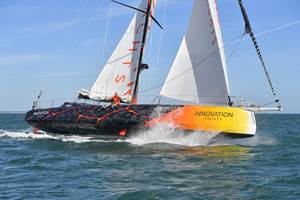48th auto-plastics competition highlights changing industry
Additive manufacturing, autonomous vehicles, greener parts featured prominently.
On November 7, a global audience of nearly 1,000 gathered for the Society of Plastics Engineers’ (SPE, Bethel, CT, US) 48th-annual Automotive Innovation Awards gala to learn this year’s category and Grand Award winners.
When it started in 1970, the competition — organized by the Automotive Division of SPE — was intended to draw automaker attention to plastics as an underutilized material in the automotive industry. At the time, most polymeric content on cars was restricted to ashtrays, buttons, knobs, rubber mats, seals and tires. To borrow a tagline from that era, “We’ve come a long way, baby.”
Today, the American Chemistry Council (Washington, DC, US) reports that polymeric materials make up 50% of the volume of new passenger vehicles but only 10% of their weight. And you’d better believe that content is increasing as we draw closer to 2025 fuel efficiency mandates in North America and tailpipe emissions mandates in much of Europe and Asia.
The trends changing how automotive plastics and composites are used have been spelled out pretty accurately in SPE’s annual parts competition over the last half-century and this year’s contest was no exception, which is why it’s so interesting to participate as a judge. For example, one of the long-standing competition rules is that nominations must be used on vehicles commercially available for purchase (or in use to produce commercial parts) by November 1st of the year the nomination is submitted — although they also can be submitted after start of production (SOP). Given the rapid growth in additive manufacturing and 3D printing technologies, and the increasing breadth of materials available, it was not surprising to see that organizers added a new category for this year’s competition for Additive Manufacturing. Eight strong nominations were entered, including lighter, more ergonomic lift assists, assembly alignment fixtures, and B-side body tools for final assembly that replaced much heavier (and often more metal-centric) traditional tools that were costlier and took far longer to produce. Carbon fiber-reinforced polyamide 12 (CF-PA12) featured prominently in several cases. Other applications included additively manufactured inserts for injection molding tools that replaced the porous, sintered metal-matrix composite, Porcerax (International Mold Steel Inc., Florence, KY, US), which reportedly is more sensitive to mold release and mold-cleaning products and doesn’t last as long. Still another application was an OEM replacement part for an older model vehicle whose original tooling had been misplaced. For the small number of parts needed each year, 3D printing was far more cost-effective than producing new injection molding tools. In fact, that application was reportedly the auto industry’s first commercial use of CLIP technology from Carbon Inc. (Redwood City, CA, US) to produce thermoset parts — in this case in epoxy.
Another sign of the times is that a front-mounted composite millimeter-wave radar bracket with breakaway functionality for pedestrian impact protection in 33% glass-reinforced PA 6/6 (GR-PA66) was a Safety category finalist. In recent years there have been more and more nominations with clever ways to incorporate forward- and rear-projecting cameras and various sensors in bumper fascia, rear fins, front grilles, and even in a rear taillight assembly. As autonomous vehicles move out of testing and begin entering roadways in quantities, expect to see more nominations like these.
The Environmental category also had a strong showing this year. Judges had to choose among applications that used up 11.9-million ft2/1.1-million m2 of old carpet backing plus 26,250 lb/11,907 kg of recycled tire rubber versus several 100% post-industrial recyclate (PIR) applications — one of which, remarkably, was a Class A exterior part — and a third that combined PIR automotive scrap plus post-consumer recyclate (PCR) from food packaging, as well as the industry’s first use of a combination of cellulose fiber (from sustainable forestry) plus long-glass fiber polypropylene (LGF-PP). In every case, weight and costs were saved, greenhouse-gas emissions reduced, and presumably more positive lifecycle analyses yielded.
Related Content
European boatbuilders lead quest to build recyclable composite boats
Marine industry constituents are looking to take composite use one step further with the production of tough and recyclable recreational boats. Some are using new infusible thermoplastic resins.
Read MoreAirbus works to improve the life cycle of composites in future aircraft
This companion article to CW's September 2024 Airbus Illescas plant tour discusses recycling, LCA, biocomposites, Fast Track technologies, qualification and more.
Read MoreBio-based, fire-resistant composites become mainstream
Projects use Duplicor prepreg panels with highest Euroclass B fire performance without fire retardants for reduced weight, CO2 footprint in sustainable yet affordable roofs, high-rise façades and modular housing.
Read MoreComposites end markets: Sports and recreation (2025)
The use of composite materials in high-performance sporting goods continues to grow, with new advancements including thermoplastic and sustainability-focused materials and automated processes.
Read MoreRead Next
Scaling up, optimizing the flax fiber composite camper
Greenlander’s Sherpa RV cab, which is largely constructed from flax fiber/bio-epoxy sandwich panels, nears commercial production readiness and next-generation scale-up.
Read MoreUltrasonic welding for in-space manufacturing of CFRTP
Agile Ultrasonics and NASA trial robotic-compatible carbon fiber-reinforced thermoplastic ultrasonic welding technology for space structures.
Read MoreNext-gen fan blades: Hybrid twin RTM, printed sensors, laser shock disassembly
MORPHO project demonstrates blade with 20% faster RTM cure cycle, uses AI-based monitoring for improved maintenance/life cycle management and proves laser shock disassembly for recycling.
Read More.jpg;width=70;height=70;mode=crop)












